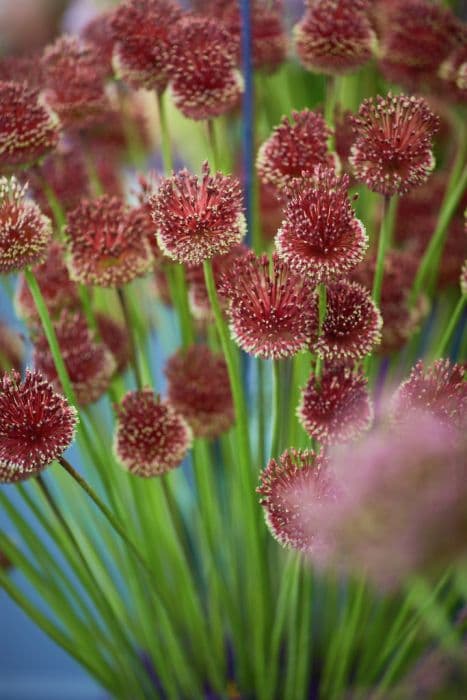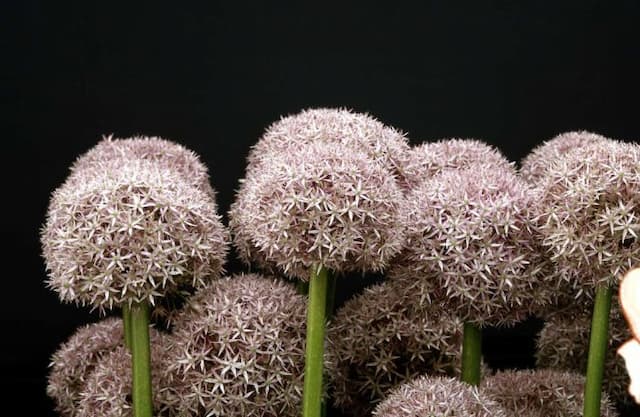Leek Allium porrum (Autumn Mammoth Group) 'Firena'

ABOUT
The 'Firena' is a member of the leek family, which is known for its edible stems and leaves. Its appearance is highlighted by long, cylindrical stems that are thick and layered, resembling oversized green onions. The stem has a white lower portion that transitions into a deep green as it extends upwards to the blue-green leaves. The leaves are flat and strap-like with a slightly wavy edge, providing a lush and leafy top. The plant typically produces white, delicate flowers arranged in a spherical shape atop tall stalks, which are often removed in culinary contexts to encourage better stem growth. Overall, the 'Firena' has a robust and upright form, with a color palette ranging from white to various shades of green.
About this plant
 Names
NamesSynonyms
Leek, Porrum.
Common names
Allium ampeloprasum var. porrum, Allium porrum.
 Toxicity
ToxicityTo humans
Leek (Allium porrum (Autumn Mammoth Group) 'Firena') is not toxic to humans and is commonly consumed as a vegetable. It does not produce any toxic effects when ingested as part of a normal diet. However, individuals with a known allergy to leeks or other members of the Allium family may experience an allergic reaction upon consuming leeks, though this is relatively uncommon.
To pets
Leek (Allium porrum (Autumn Mammoth Group) 'Firena') is toxic to pets, especially cats and dogs. Ingesting leeks can cause oxidative damage to red blood cells, leading to conditions such as hemolysis, hemolytic anemia, or methemoglobinemia. Symptoms of poisoning from consumption of leeks can include vomiting, diarrhea, abdominal pain, weakness, lack of appetite, pale or yellow mucous membranes, reddish urine, difficulty breathing, and lethargy. It is important to keep leeks away from pets and seek veterinary care if a pet has consumed any part of the plant.
 Characteristics
CharacteristicsLife cycle
Biennials
Foliage type
Deciduous
Color of leaves
Green
Height
1-3 feet (30-90 cm)
Spread
0.5-1 feet (15-30 cm)
Plant type
Herb
Hardiness zones
5
Native area
Europe
Benefits
 General Benefits
General Benefits- Culinary Uses - Leek 'Firena' has a mild onion-like flavor and is widely used in cooking, adding a subtle depth to soups, stews, and sautéed dishes.
- Nutritional Content - It is a good source of dietary fiber, vitamins A, C, and K, and contains important minerals like iron and manganese.
- Easy to Grow - This variety is particularly known for its hardiness and can be easily grown in a variety of climates and soil types.
- Garden Aesthetics - Leek 'Firena' has attractive, long, white stems with dark green leaves that can add height and visual interest to vegetable gardens.
- Culinary Versatility - It can be consumed raw in salads, grilled, roasted, or used as a flavor base for a multitude of recipes.
- Long Harvest Period - Leeks generally have a long harvesting window, which allows gardeners to pick them over an extended period of time.
- Low Calorie - This vegetable is low in calories, making it a healthy addition to any diet focused on weight management or maintenance.
 Medical Properties
Medical Properties- Antioxidant - Leek (the common name for Allium porrum) contains certain compounds that have antioxidant properties, which can help in neutralizing free radicals in the body.
- Antimicrobial - The natural compounds in leeks, such as allicin, may possess antimicrobial activities against various microorganisms.
- Cardiovascular health - Leeks are known for their potential positive impact on heart health due to their content of flavonoids and polyphenols.
- Digestive support - Leeks are a source of dietary fiber, which can promote healthy digestion and prevent constipation.
- Anti-inflammatory - The presence of bioactive compounds in leeks might contribute to anti-inflammatory effects which can as consequence help in reducing inflammation-related ailments.
- Bone health - Leeks contain vitamins and minerals such as vitamin K, which plays a role in bone health and may contribute to maintaining strong bones.
- Diuretic properties - Due to their high water content and presence of certain nutrients, leeks might have a mild diuretic effect, helping to remove excess fluids from the body.
 Air-purifying Qualities
Air-purifying QualitiesThis plant is not specifically known for air purifying qualities.
 Other Uses
Other Uses- Leek 'Firena' can be used in flower arrangements, with its long, sturdy stems providing a unique texture and a touch of greenery.
- The fibrous leaves of leeks can be dried and woven into biodegradable garden twine to support climbing plants.
- Leek seed heads offer architectural interest in dried floral crafts and can be sprayed with metallic paint for a decorative effect.
- The tall, linear form of leek plants can act as a natural garden marker or border to visually separate different garden sections.
- When trimmed into thin strips, leek leaves can be used as a natural binding material in plant grafting.
- Leek plants can be utilized in educational projects to study plant growth and root development in transparent containers.
- The white stems of leeks can be carved or etched with designs, creating organic art pieces for a dinner table setting.
- Used creatively in landscape design, leeks can function as a living sculpture by planting them in patterned rows or shapes.
- Leek flowers, once pollinated, attract beneficial insects to the garden, aiding in the overall health of the ecosystem.
- The residue water from cleaning or boiling leeks can be repurposed to water plants, as it contains nutrients leeched from the leeks.
Interesting Facts
 Feng Shui
Feng ShuiThe leek is not used in Feng Shui practice.
 Zodiac Sign Compitability
Zodiac Sign CompitabilityThe leek is not used in astrology practice.
 Plant Symbolism
Plant Symbolism- Perseverance and Hardiness: 'Firena', being a variety of leek, is known for its ability to withstand cold weather, symbolizing the human virtues of perseverance and resilience in the face of adversity.
- Protection and Warding Off Evil: Historically, leeks have been used in folklore to protect against evil spirits and are often associated with warding off misfortune.
- Healing and Health: Leeks are known for their beneficial properties and have been considered a symbol of healing and nurturing health due to their nutritional value.
- Pride and Victory: Leeks are a national emblem of Wales and are associated with Welsh pride and the memory of past victories, particularly the battle against the Saxons where, according to legend, Welsh soldiers wore leeks to identify allies.
 Water
WaterLeeks prefer consistent moisture to ensure steady growth, so water the leeks, specifically the Autumn Mammoth 'Firena', generously once a week with about 1 to 1.5 gallons per square yard, depending on the weather. In very hot or dry periods, increase watering to twice per week. Ensure the water penetrates the soil deeply to encourage the roots to grow downward. Avoid overhead watering to prevent disease, and instead use soaker hoses or drip irrigation for deep watering at the base of the plants. During rainy periods, reduce the amount to prevent waterlogging.
 Light
LightLeeks, such as the Autumn Mammoth 'Firena', thrive best in full sunlight with at least six hours of direct sunlight per day. They are able to tolerate partial shade but prefer a sunny spot for optimal growth. Ensure the chosen spot is clear of tall plants or structures that could cast shade on the leeks during the crucial sunlit hours.
 Temperature
TemperatureThe ideal temperature range for growing leeks like Autumn Mammoth 'Firena' is between 55°F and 75°F. They can survive temperatures as low as 20°F and as high as 90°F, but growth may be stunted outside the ideal range. They perform best in climates with cooler summers and can even withstand light frosts without issue.
 Pruning
PruningPruning is not typically necessary for leeks such as the Autumn Mammoth 'Firena'. However, removing damaged or yellowing leaves is beneficial for maintaining health and can be done as needed. This helps prevent disease and encourages better growth throughout the season.
 Cleaning
CleaningAs needed
 Soil
SoilLeeks, the common name for Allium porrum 'Firena', prefer well-drained, fertile soil with plenty of organic matter, and a pH between 6.0 and 7.0 is ideal for their growth.
 Repotting
RepottingLeeks typically do not require repotting as they are biennials grown annually; instead, they are direct-sown or transplanted once into the garden.
 Humidity & Misting
Humidity & MistingLeeks, commonly known, thrive best in outdoor environments where ambient humidity is generally sufficient and do not require specific humidity levels.
 Suitable locations
Suitable locationsIndoor
For leeks, ensure bright light, cool temps, and good air circulation.
Outdoor
Plant in full sun, fertile soil, spaced adequately for growth.
Hardiness zone
5-9 USDA
 Life cycle
Life cycleAllium porrum, commonly known as leek, begins its life cycle when seeds are sown directly into the soil or started indoors before the last frost. They germinate within two weeks under ideal conditions, starting as thin, grass-like seedlings. As the leek grows, it enters a vegetative stage characterized by the elongation of the edible white stem (pseudostem) and the development of flat, strap-like green leaves. Leeks typically reach maturity in about 120 to 150 days, with 'Firena' cultivars producing thick, long stems and deep green foliage. For harvesting, leeks are lifted from the soil when the pseudostem reaches the desired thickness, usually an inch or more in diameter. After harvest, if leeks are left to flower, they'll produce a round, globular umbel of tiny flowers, followed by seed set, thus completing their biennial cycle if they survive through the winter.
 Propogation
PropogationPropogation time
Spring to Summer
Leek (Allium porrum 'Firena') is typically propagated by seed. The most popular method for propagating leeks is by sowing seeds indoors in early spring, about 8 to 10 weeks before the last expected frost date. To do so, fill a seed tray with a fine seed starting mix, and sprinkle the leek seeds across the soil evenly. Cover the seeds lightly with soil—about 1/4 inch (0.6 cm) deep—and water gently. The seed tray should be kept in a warm, well-lit area and maintained at a consistent moisture level. Seedlings usually emerge within two weeks, and once they've grown large enough to handle, usually around 6 inches (15 cm) tall, they can be transplanted into the garden, spaced about 6 inches apart, in rows 12 inches (30 cm) apart.









